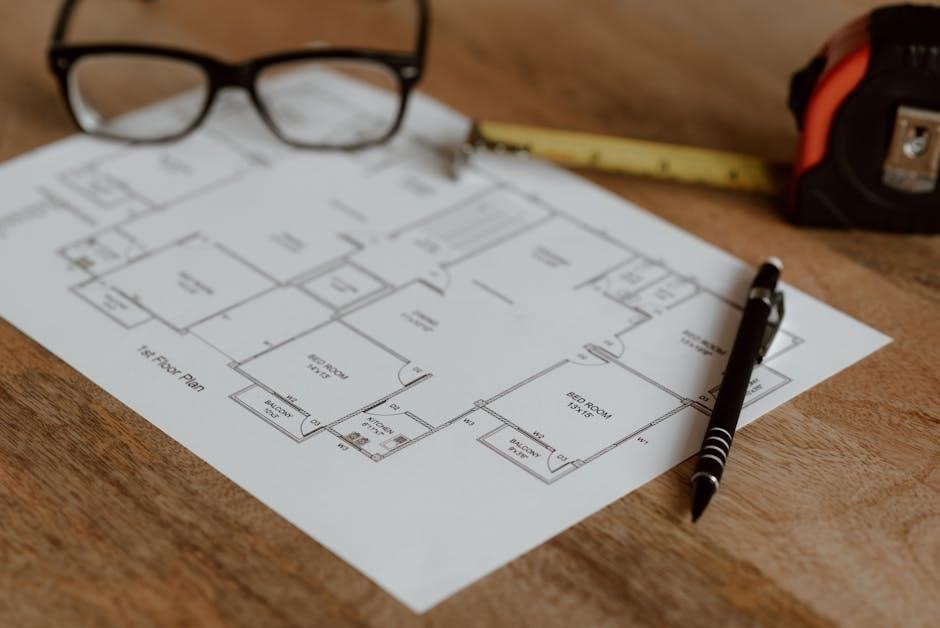A home wiring diagram is an essential guide for understanding electrical connections. It provides a visual representation of circuits‚ devices‚ and wiring layouts‚ ensuring safe installation and troubleshooting.
1.1 What is a Home Wiring Diagram?
A home wiring diagram is a detailed visual representation of a house’s electrical system. It illustrates the connections between various components‚ such as switches‚ outlets‚ and circuits. The diagram uses standardized symbols to depict devices‚ wires‚ and their interconnections. It serves as a blueprint for installing‚ maintaining‚ or troubleshooting electrical systems. Key elements include power sources‚ lighting systems‚ grounding‚ and circuit breakers. By following the diagram‚ users can understand how electricity flows through the home‚ ensuring safe and efficient connections. It is essential for both DIY enthusiasts and professionals to adhere to local electrical codes and safety guidelines when interpreting or creating wiring diagrams.
1.2 Importance of Home Wiring Diagrams
A home wiring diagram is crucial for ensuring safety and efficiency in electrical installations. It provides a clear map of the electrical system‚ helping to identify potential hazards and avoid accidents. By following the diagram‚ homeowners and electricians can adhere to local electrical codes and standards‚ ensuring compliance with safety regulations. It also simplifies troubleshooting‚ allowing quick identification of faults or overloaded circuits. Additionally‚ a wiring diagram serves as a guide for future modifications or upgrades‚ preventing errors during renovations. Overall‚ it is an essential tool for maintaining a safe‚ functional‚ and energy-efficient home electrical system.

Key Components of a Home Wiring Diagram
A home wiring diagram includes circuits‚ symbols‚ power systems‚ and connections. It outlines electrical components like switches‚ outlets‚ and breakers‚ ensuring a clear and organized system design.
2.1 Symbols Used in Wiring Diagrams
Wiring diagrams rely on standardized symbols to represent electrical components. Common symbols include resistors‚ capacitors‚ inductors‚ batteries‚ switches‚ and fuses. These symbols simplify the diagram‚ making it easier to understand the flow of electricity and the layout of devices; Each symbol corresponds to a specific component‚ ensuring clarity and consistency. For example‚ a battery is often shown as two parallel lines with a plus and minus sign‚ while a switch is represented by a broken line with contact points. Accurate interpretation of these symbols is crucial for safe and correct electrical installations. They also help technicians and DIYers identify components quickly‚ ensuring compliance with safety standards and electrical codes.

2.2 Understanding Circuits and Connections
Understanding circuits and connections is fundamental for interpreting home wiring diagrams. A circuit is a path through which electricity flows‚ while connections refer to how components are linked. In wiring diagrams‚ circuits are typically represented as closed loops‚ showing the flow of current from the power source through devices and back. Connections are depicted using lines and symbols‚ indicating how wires and components interact. Properly identifying circuits and connections ensures safe and functional electrical systems. This knowledge helps in troubleshooting faults‚ such as open circuits or short circuits‚ and in planning installations. Familiarity with circuit types‚ like series or parallel configurations‚ is also essential for understanding how power is distributed in a home wiring system.
2.3 Power‚ Lighting‚ and Grounding Systems
Power‚ lighting‚ and grounding systems are critical components in home wiring diagrams. These systems ensure safe and efficient electrical distribution. Power systems include main circuits and branch circuits‚ delivering electricity to outlets and appliances. Lighting systems involve wiring for fixtures‚ switches‚ and dimmers‚ often requiring separate controls. Grounding systems are essential for safety‚ providing a path for excess current to the earth‚ preventing shocks and fires. Proper installation and representation of these systems in wiring diagrams are vital for compliance with electrical codes. They also help in identifying potential hazards and ensuring reliable operation of all electrical components in a home. Accurate diagrams guide technicians and DIYers in maintaining and upgrading these systems effectively.

Planning and Design Considerations
Effective planning ensures a safe and efficient home wiring system. Assess electrical needs‚ select materials‚ and design layouts to meet local codes and future requirements.
3.1 Load Calculation for Home Wiring
Load calculation is crucial for determining the electrical demands of a home. It involves summing the power ratings of all appliances and devices to ensure the wiring system can handle the total load. Proper calculation prevents overheating and ensures safety. Factors like voltage drop and future electrical needs should be considered. A detailed wiring diagram helps in visualizing and planning the distribution of power efficiently. Adding a 20% safety margin to the calculated load is recommended to account for unexpected usage spikes. Accurate load calculation ensures the system operates reliably and meets local electrical codes. Incorrect calculations can lead to system failures or fire hazards‚ making professional consultation advisable for complex setups.
3.2 Wire Sizing and Material Selection
Wire sizing and material selection are critical for ensuring safe and efficient electrical connections. The size of the wire‚ measured in AWG (American Wire Gauge)‚ must be appropriate for the current it will carry. Larger wires can handle higher currents without overheating. Materials like copper or aluminum are commonly used due to their conductivity. Insulation type and thickness also matter for safety and durability. Factors such as voltage drop‚ circuit length‚ and environmental conditions influence these choices. Proper selection prevents overheating and ensures reliable power distribution. Consulting a wiring diagram or an electrician is recommended to meet local codes and safety standards. Incorrect wire sizing can lead to system failures or fire hazards.
3.3 Circuit Planning and Layout
Circuit planning and layout are essential for a safe and efficient home wiring system. Start by identifying power sources‚ outlets‚ and appliance locations. Plan circuits to avoid overloaded breakers by distributing loads evenly across multiple circuits. Consider future electrical needs to ensure scalability. Use wiring diagrams to map out connections‚ ensuring compliance with local electrical codes. Proper layout minimizes wire runs‚ reducing voltage drop and material costs. Labeling circuits clearly is crucial for maintenance and troubleshooting. Grounding systems must be incorporated to ensure safety. A well-planned layout prevents electrical hazards and ensures reliable power distribution throughout the home. Always consult a professional if unsure about complex configurations or code requirements.

Installation Steps for Home Wiring
Installation involves mounting components‚ connecting wires‚ and testing circuits. Ensure all connections are secure and meet safety standards. Use wiring diagrams to guide the process accurately.
4.1 Preparing for Installation
Before starting the installation‚ plan the wiring layout using a detailed diagram. Calculate the load requirements and ensure materials meet local electrical codes. Gather necessary tools‚ wires‚ and components. Turn off the power supply at the main breaker for safety. Inspect existing wiring for damage or wear. Label circuits and connections clearly. Verify grounding systems are in place. Familiarize yourself with safety guidelines to prevent accidents. Review the wiring diagram thoroughly to understand the sequence of connections; Ensure all materials are fire-resistant and suitable for residential use. Proper preparation ensures a smooth and safe installation process‚ minimizing risks and ensuring compliance with electrical standards.
4.2 Mounting Electrical Components
Mounting electrical components requires precision to ensure safety and functionality. Start by identifying the locations for outlets‚ switches‚ and circuit breakers using the wiring diagram. Ensure all components are installed at the correct height and spacing as per local codes. Use screws or anchors to secure devices firmly to walls or surfaces. For heavier items like circuit breakers‚ ensure the mounting surface is sturdy. Connect wires carefully‚ following the diagram to avoid mismatches. Double-check that all connections are tight and insulated. Test each component to confirm proper functioning. Keep components away from heat sources and flammable materials. Proper mounting ensures reliability‚ safety‚ and compliance with electrical standards‚ preventing future issues.
4.3 Connecting Wires and Circuits
Connecting wires and circuits is a critical step in home wiring. Begin by referring to the wiring diagram to identify the correct connections for each component. Ensure all power sources are turned off before starting. Use a multimeter to verify that no live voltage is present. Connect wires to outlets‚ switches‚ and circuit breakers‚ matching colors to ensure proper phase and neutral connections. Avoid overloading circuits by distributing power evenly. Secure all connections tightly to prevent loose wires‚ which can cause fires or shorts. Label wires for clarity. Double-check the diagram to confirm all connections are accurate. Test each circuit individually to ensure functionality. Proper connections ensure safety‚ efficiency‚ and reliability in your home wiring system.
4.4 Testing the Wiring System
Testing the wiring system ensures safety and functionality. Begin by using a multimeter to check for voltage at each outlet and switch. Verify that all live wires show the correct voltage‚ while neutral wires should show zero. Test circuit continuity to ensure proper connections and identify any short circuits or open circuits. Check grounding systems to confirm they are functioning correctly. Test each circuit individually to ensure it operates as intended. Use a circuit tester to verify polarity and detect any faulty connections. Perform a final inspection to ensure all wires are securely connected and no loose ends remain. Testing is crucial to prevent electrical hazards and ensure the system operates efficiently.

Safety Tips and Precautions
Always turn off the power supply before working on wiring. Use a multimeter to confirm zero voltage. Wear protective gear like gloves and goggles. Avoid wet conditions to prevent shocks. Never overload circuits‚ as this can cause fires. Follow local electrical codes strictly. Keep flammable materials away from wiring. Regularly inspect wires for damage or wear. Ensure all connections are secure and tight. Avoid DIY repairs without proper knowledge. Consult professionals for complex tasks. Regular maintenance can prevent electrical hazards. Stay informed about electrical safety guidelines to protect your home and family.
5.1 Electrical Safety Guidelines
Always turn off the power supply before starting any wiring work. Use a multimeter to verify zero voltage at circuits and devices. Wear protective gear‚ including insulated gloves and safety goggles‚ to prevent electrical shocks. Ensure the workspace is dry and well-lit to minimize accident risks; Never overload circuits‚ as this can lead to overheating and fires. Familiarize yourself with local electrical codes and regulations to ensure compliance. Use fire-resistant materials for wiring and connections. Regularly inspect wires and components for damage or wear; Avoid using damaged tools or equipment‚ as they can increase safety hazards. Keep children and pets away from electrical work areas. Consult a licensed electrician for complex tasks. Properly label all wires and circuits for future reference. Educate family members on basic electrical safety to prevent accidents. Always follow the manufacturer’s instructions for electrical devices and components. By adhering to these guidelines‚ you can ensure a safe and reliable electrical system in your home.

5.2 Fire Safety and Prevention
Fire safety is crucial in home wiring to prevent electrical fires. Overloaded circuits‚ faulty wires‚ and poor connections are common causes of fire hazards. Ensure all wires and components are properly insulated and regularly inspected for damage or wear. Avoid using damaged or frayed cords‚ as they can spark and ignite fires. Install smoke detectors and ensure they are functional. Keep fire extinguishers rated for electrical fires nearby. Never overload outlets or extension cords‚ as this can lead to overheating. Use fire-resistant materials for wiring and connections. Avoid DIY repairs without proper knowledge‚ as they can create fire risks. Regularly inspect your electrical system and address any issues promptly. Stay informed about local fire safety codes and regulations to ensure compliance. By taking these precautions‚ you can significantly reduce the risk of electrical fires in your home.
5.3 Emergency Procedures
In case of an electrical emergency‚ such as a fire or circuit overload‚ act quickly and safely. First‚ switch off the main power supply at the circuit breaker or fuse box. Do not use water to extinguish electrical fires; instead‚ use a fire extinguisher rated for electrical fires. Evacuate the premises immediately and call emergency services. If someone is shocked‚ avoid direct contact and turn off the power source before providing assistance. Keep emergency contact numbers accessible and ensure all household members know the procedure. Regularly inspect wiring for hazards and address them promptly. Having a well-prepared emergency plan can prevent accidents and ensure safety. Always stay informed about proper emergency protocols for electrical incidents.

Common Issues and Troubleshooting
Common wiring issues include flickering lights‚ tripped circuit breakers‚ and outlets not working. Check connections for loose wires and ensure circuits are not overloaded.
6.1 Identifying Faults in Wiring
Identifying faults in wiring requires careful inspection of the electrical system using a multimeter to detect voltage drops or short circuits. Look for signs like flickering lights or tripping circuit breakers‚ as these may indicate overloaded circuits or faulty connections. Check for loose wires or damaged insulation‚ which can lead to fire hazards. Referencing a home wiring diagram can help locate potential problem areas. Always ensure the power is off before inspecting wires to avoid electrical shocks. If unsure‚ consult a licensed electrician for professional diagnosis and repair to ensure safety and compliance with local codes. Regular maintenance can prevent major issues.
6.2 Repairing Damaged Wires and Connections
Repairing damaged wires and connections requires careful attention to detail to ensure safety and functionality. Start by turning off the power supply and verifying it with a multimeter. Strip the damaged insulation and clean the wire ends before reconnecting. Use appropriate connectors or soldering techniques to secure the wires‚ ensuring no loose ends remain. For frayed or exposed wires‚ replace the damaged section entirely with fire-safe‚ high-quality materials. After repairs‚ test the circuit to confirm proper operation. If unsure‚ consult a professional electrician to avoid hazards. Regular inspections can prevent such issues‚ maintaining the integrity of your home wiring system. Always follow local electrical codes for compliance and safety.
6.3 Resetting Circuit Breakers
Resetting circuit breakers is a common task when dealing with electrical issues. First‚ ensure all connected devices are turned off to prevent power surges. Locate the circuit breaker panel and identify the tripped breaker‚ which will be in the “off” position. Firmly switch it to the “reset” position. Test the circuit by turning on devices one by one to check for proper function. If the breaker trips again‚ it may indicate an overloaded circuit or a short circuit. Use a multimeter to check for faults before resetting. Regular inspections and load balancing can prevent frequent tripping. Always follow safety guidelines to avoid electrical hazards.

Resources and References
Find reliable home wiring diagrams in official manuals‚ PDF guides‚ and educational resources. Use online tools and diagrams from trusted sources for accurate and safe electrical installations.
7.1 Where to Find Reliable Wiring Diagrams
Reliable wiring diagrams can be found in official manufacturer manuals‚ educational resources‚ and trusted online platforms. Websites offering PDF guides‚ such as those from the Canadian Electrical Code or specific product manuals‚ provide detailed schematics. Additionally‚ educational institutions and DIY electrical forums often share verified diagrams. Ensure sources are credible and up-to-date to guarantee safety and compliance with local electrical codes. Avoid unverified diagrams from unofficial sources to prevent potential risks. Always cross-reference diagrams with official guidelines for accuracy.
7.2 Recommended Books and Manuals
For comprehensive guidance‚ several books and manuals are highly recommended. The National Electrical Code (NEC) Handbook is a cornerstone‚ offering detailed wiring standards. “Wiring Diagrams for Houses” provides clear‚ practical schematics. Additionally‚ “Electrical Wiring Diagrams for Residential Applications” is a valuable resource. These materials are widely available in PDF formats‚ ensuring accessibility. Manufacturer-specific manuals‚ like those from solar panel and trailer wiring systems‚ also offer tailored guidance. Always consult updated editions to ensure compliance with current safety standards and regulations. These resources are essential for both professionals and DIY enthusiasts‚ providing detailed instructions and diagrams for safe and efficient electrical installations.
7.3 Online Tools for Wiring Design
Various online tools simplify wiring design‚ offering user-friendly interfaces and comprehensive features. Tools like Fritzing and SmartDraw enable users to create detailed wiring diagrams efficiently. Online platforms provide access to pre-made templates and libraries of electrical symbols. Some tools allow real-time collaboration‚ making it easier for professionals to work together. Additionally‚ many websites offer PDF exports‚ ensuring compatibility with standard documentation formats. These tools cater to both beginners and experts‚ streamlining the design process and reducing errors. They are invaluable for planning and visualizing home wiring systems‚ ensuring safety and compliance with electrical codes. Utilizing these resources can significantly enhance the accuracy and efficiency of wiring projects.

Best Practices for Home Wiring
Adhering to local electrical codes ensures safety and compliance. Regular inspections and upgrades prevent hazards. Proper wire sizing and grounding are crucial for reliable performance and fire prevention.
8.1 Following Local Electrical Codes
Compliance with local electrical codes is crucial for safety and legal adherence. These codes outline specific requirements for wiring installations‚ ensuring systems are hazard-free and efficient. Proper load calculations‚ wire sizing‚ and grounding are mandated to prevent overloads and ensure reliable performance. Inspections by certified professionals are often required to verify adherence. Fire safety measures‚ such as fire-resistant materials‚ are also specified. Deviating from codes can lead to legal penalties and increased risk of electrical fires or failures. Always consult updated code manuals or local authorities for precise guidelines tailored to your region.
8.2 Regular Maintenance and Inspections
Regular maintenance and inspections are vital for ensuring the longevity and safety of your home wiring system. Over time‚ wires can degrade‚ connections can loosen‚ and components can fail. Schedule annual inspections by licensed electricians to identify potential issues before they escalate. Check for signs of wear‚ such as frayed wires or flickering lights‚ and address them promptly. Maintain a record of inspections and repairs for future reference. Proper upkeep prevents electrical hazards‚ reduces fire risks‚ and ensures optimal system performance. Additionally‚ stay informed about updates to your wiring diagram to adapt to new technologies or household needs. Consistent care safeguards your home and family.
8.3 Upgrading Your Wiring System
Upgrading your wiring system ensures it meets modern electrical demands and safety standards. Start by assessing your current setup using a wiring diagram to identify outdated components. Consult a licensed electrician to evaluate your system’s capacity and recommend necessary upgrades. Replace worn-out wires‚ install new outlets‚ and update circuit breakers to handle increased power needs. Consider future-proofing by installing higher-gauge wires for potential additions like smart home devices. Ensure all upgrades comply with local electrical codes and include proper grounding for safety; Regular system upgrades prevent electrical hazards‚ enhance efficiency‚ and support new technologies. Always prioritize professional assistance for complex modifications.
